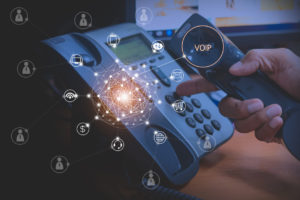Many small businesses have either made the switch or are thinking about making the switch to Voice over Internet Protocol(VoIP) services. VoIP has the ability to provide many benefits and advantages to your business over landline phones. Today, we want to provide more insight into VoIP, including the features you may not be aware of.
Voicemail to Email Transcription
Did you know that one of the ways VoIP could simplify your workflow is by translating your voicemails to text? It does not matter if you have been away from your business for an extended period of time or if you generally receive a high volume of calls on a daily basis, you can use this feature to make sure you never miss a voicemail message.
When you use this feature, you will be able to open your inbox, click the message, and listen to the message that was left for you. You will also be able to manage your email inbox by removing, saving, or forwarding the voicemails you have received. You will no longer have to worry about frantically looking for paper and pencil to write down phone numbers and names from the voicemail message.
Conference Calling
While conference calling may not be a feature that is necessarily hidden, this feature can be used in more ways than many business owners know about. When conference calling is used, audio meetings can be held with dozens or hundreds of attendants through any device that is connected to an internet network.
Conference calling can be of great use for businesses that have created remote teams. Conference calls will allow teams to work collaboratively even when they are miles apart.
Call Recording
If you want to record incoming and outgoing calls for training purposes or for reference purposes, we encourage you to use the Call Recording feature that is available. Depending on the type of service you are able to use, the calls can be recorded individually or on a company-wide basis.
There are some call recording solutions that will offer storage space in the cloud so you will not have to store every phone call on your network. There will be times when you will want to save some conversations for a variety of reasons, and call recording is a great feature that will allow you to do this.
Call Screening
If you want to feel in control of the calls you answer, you can make use of the call screening feature. As we all know, Caller ID provides information about who is calling so that you can make the decision to answer, decline, or send the call to voicemail.
The call screening process can also ask callers to state their name and any other identifying information. The information the caller leaves will be relayed to you. We understand that you are not always able to answer every call that comes in, so the call screening feature will allow you to answer the calls you feel are a priority.
Do Not Disturb
This feature probably does not need an in-depth overview. The “Do Not Disturb” feature can be put to great use when you do not want to be interrupted for an extended period of time. If you are in the middle of another phone call or if you are in the middle of a face-to-face meeting, this feature will allow you to turn the ringer off the phone during this time.
Do you currently have VoIP services? Are there any features you have not used because you were not aware they were available? If you would like to learn more about VoIP features that can improve your business, please do not hesitate to contact us today.



